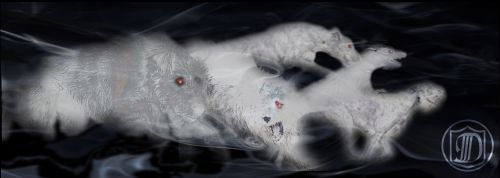My visual interpretation of Arawn is influenced by more modern interpretations, such as Disney’s The Black Cauldron, which takes its influence from the second book of Lloyd Alexander’s, The Chronicles of Prydain. But in my rhyme, “Arawn’s Ride” is about a reckoning for evil doers -- it’s about retribution. The blackbird signifies the raven synonymous with war goddess, the Morrígan.
Sing a song of darkness
a heartbeat’s thump and thud
Blackbird sings for Arawn’s
hoary hounds flood
When Annwn’s gates are opened
baying specters pour forth
Rogues do fear Arawn’s coming
reckoning comes henceforth
Arawn lets loose his coursers
a chariot drawn by fire
Death borne by equine flames
ghosts swarm and gyre
The dance of Death sweeps forth
grasping icy tendril
Spectral fingers that curl and coil
to drag you down to Hell

The Pre-Christian Celtic Lore
The origin of lore for Arawn comes from the Welsh Celtic tradition. He was primarily associated with fairness and justice. Arawn came to be known as the god of death and the underworld, of war and retribution. He began as the joyous king of Annwn, the “Otherworld”.
Annwn was an underworld lore originally having more in common with the Greek Elysian Fields than the Dantesque hell it morphed into. Annwn, in the original Welsh Celtic conception, was an idyllic underworld realm of eternal youth and bliss for souls of the dead, a peaceful final resting place and haven of plenty.
Arawn was variously described in Celtic folklore as the Guardian of the Lost Souls, or the Provider, and the Virtuous. The god of death also symbolized hunting and war, as well as terror and retribution. In more pedantic descriptions, he is a tall figure in a grey cloak on a stately grey horse. In more typical storytelling traditions, Arawn is described as a looming, tall figure who appears on a spectral horse and manifests about himself a smoldering cloak.
The Hounds of Annwn or “Cwn Annwn” are the faithful spectral hounds belonging to Arawn. His faithful white-eared, red-eyed hounds exist at his side in the Otherworld, or underworld. Like the original conception of the god, they represented loyalty, guidance, hunting, and death. The hounds were known for the Wild Hunt, romping through the autumn and winter nights hunting evil spirits and terrorizing wrongdoers. It was said the baying of their howls was an omen of death and lured wandering spirits to their final resting place in Annwn.
However, between the Roman demonization of all things Celtic in the British Isles and the spread of Christianity, Arawn’s connection to death and the underworld saw him increasingly demonized. The god was transformed into a force of darkness and evil by the time we begin to see him in literature, depicted as a more Dantesque evil tormentor. His hounds became satanic hounds of Hell. And, Annwn became a place of tormented souls.
From the Welsh Ceredigion (Cardigan) meaning “Ceredig’s land” (Cardiganshire) comes a now rather archaic colloquialism. It is still used poetically to express the sense of interminable waiting, or how slowly time seems to pass: “Hir yw’r dydd a hir yw’r nos, a hir yw aros Arawn.” This roughly translates to “Long is the day, and long is the night. And long is the waiting of Arawn.”
If you enjoyed my offering, please buy me a coffee with Ko-fi
The origin of lore for Arawn comes from the Welsh Celtic tradition. He was primarily associated with fairness and justice. Arawn came to be known as the god of death and the underworld, of war and retribution. He began as the joyous king of Annwn, the “Otherworld”.
Annwn was an underworld lore originally having more in common with the Greek Elysian Fields than the Dantesque hell it morphed into. Annwn, in the original Welsh Celtic conception, was an idyllic underworld realm of eternal youth and bliss for souls of the dead, a peaceful final resting place and haven of plenty.
Arawn was variously described in Celtic folklore as the Guardian of the Lost Souls, or the Provider, and the Virtuous. The god of death also symbolized hunting and war, as well as terror and retribution. In more pedantic descriptions, he is a tall figure in a grey cloak on a stately grey horse. In more typical storytelling traditions, Arawn is described as a looming, tall figure who appears on a spectral horse and manifests about himself a smoldering cloak.
The Hounds of Annwn or “Cwn Annwn” are the faithful spectral hounds belonging to Arawn. His faithful white-eared, red-eyed hounds exist at his side in the Otherworld, or underworld. Like the original conception of the god, they represented loyalty, guidance, hunting, and death. The hounds were known for the Wild Hunt, romping through the autumn and winter nights hunting evil spirits and terrorizing wrongdoers. It was said the baying of their howls was an omen of death and lured wandering spirits to their final resting place in Annwn.
However, between the Roman demonization of all things Celtic in the British Isles and the spread of Christianity, Arawn’s connection to death and the underworld saw him increasingly demonized. The god was transformed into a force of darkness and evil by the time we begin to see him in literature, depicted as a more Dantesque evil tormentor. His hounds became satanic hounds of Hell. And, Annwn became a place of tormented souls.
From the Welsh Ceredigion (Cardigan) meaning “Ceredig’s land” (Cardiganshire) comes a now rather archaic colloquialism. It is still used poetically to express the sense of interminable waiting, or how slowly time seems to pass: “Hir yw’r dydd a hir yw’r nos, a hir yw aros Arawn.” This roughly translates to “Long is the day, and long is the night. And long is the waiting of Arawn.”
If you enjoyed my offering, please buy me a coffee with Ko-fi
 Support Me on Ko-fi
Support Me on Ko-fi
 Flag Writing
Flag Writing